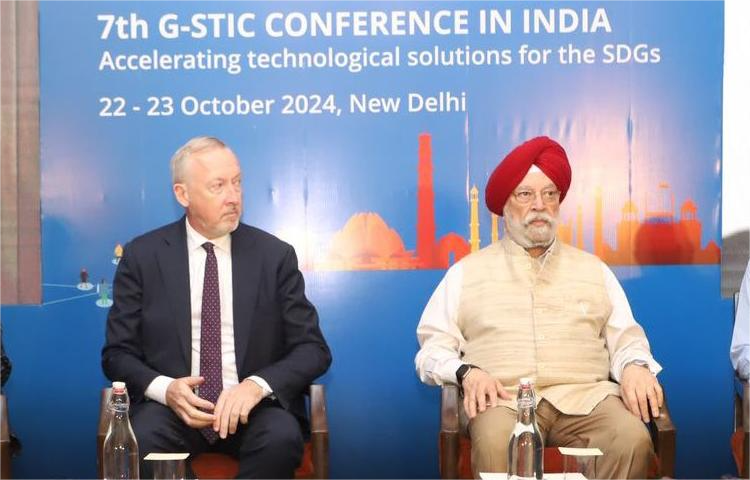7th G-STIC Delhi Conference: Hardeep Singh Puri Emphasizing India’s Sustainable Energy Transition
Minister Puri highlighted the transformative effect of the Ujjwala scheme, launched in 2016, which has dramatically increased access to cooking gas.

- Country:
- India
At the 7th G-STIC Delhi Conference on “Accelerating Technological Solutions for the SDGs,” Shri Hardeep Singh Puri, Minister of Petroleum and Natural Gas, outlined India's evolving strategies towards sustainable energy. He emphasized the potential of these technological advancements for replication across the Global South and discussed the complexities surrounding energy transitions within democratic frameworks, noting that the challenges may differ in democratic contexts.
A Milestone Event in Sustainable Innovation
The 7th G-STIC Conference, hosted in India for the first time, is organized by TERI (The Energy and Resources Institute) and VITO (Flemish Institute for Technological Research) in collaboration with eight independent not-for-profit technology research institutes. The conference is centered on the theme “Harmonizing Technology, Policy, and Business Pathways for Sustainable Future and Coexistence,” focusing on collaborative solutions to pressing global challenges.
Balancing Energy Trilemma
In his inaugural address, Minister Puri addressed the critical trilemma facing democratically elected governments worldwide: balancing affordability, availability, and sustainability in energy policy. He projected that India's energy consumption is expected to rise significantly, from 5.4 million barrels per day today to an anticipated 7 million barrels per day by 2030. This surge places India in a pivotal position, projected to account for 25% of the increase in global energy demand over the next two decades.
Innovations in Energy Solutions
Affordability remains a key focus in India's energy transition. Puri highlighted the government's commitment to research and development, citing initiatives like hydrogen fuel cell technology being piloted in public transportation. Currently, 15 hydrogen-powered buses are operational in demonstration phases, exemplifying India’s broader vision for sustainable transport solutions aimed at reducing carbon emissions.
A notable achievement discussed was the significant progress in ethanol blending, which has increased from just 1.53% in 2013-14 to 16% today. Encouraged by this success, the government has expedited its blending target of 20% from 2030 to 2025, indicating a proactive and strategic approach towards energy sustainability. Plans are underway to explore sustainable energy solutions beyond the 20% target, reflecting a forward-looking vision for India's energy landscape.
Supporting Developing Nations in Energy Needs
Puri underscored the necessity of addressing energy requirements in developing nations, particularly within the Global South, where reliance on energy imports is prevalent. He expressed optimism that India's successful ethanol initiatives could serve as a model for these countries, even as he acknowledged India's constraints—specifically, the limited arable land available for biofuel production compared to Brazil. Nonetheless, he emphasized the potential for innovative biofuel strategies to reduce import dependency while catering to local energy needs.
Social Impact of Energy Initiatives
Minister Puri highlighted the transformative effect of the Ujjwala scheme, launched in 2016, which has dramatically increased access to cooking gas. The scheme has expanded the number of cylinder connections from 140 million to 330 million, providing clean cooking fuels to economically weaker sections of society. This initiative, alongside other social welfare programs under Prime Minister Narendra Modi’s leadership, has contributed to lifting approximately 250 million people out of multidimensional poverty.
Green Hydrogen: The Future of India’s Energy Landscape
In closing, Shri Hardeep Singh Puri emphasized the game-changing potential of green hydrogen for India's energy future. He stressed the importance of fostering local demand, production, and consumption to make green hydrogen a viable energy source. The primary challenge remains reducing production costs, and he urged continued innovation and scaling of technology within this sector.
As India navigates its path toward sustainable energy solutions, the insights and collaborative discussions fostered at the G-STIC Conference will play a critical role in shaping the future of energy policy and technology not just in India, but across the Global South. With a commitment to harmonizing technological advancements and policy frameworks, the conference represents a significant step toward a sustainable energy future for all. 4o mini
- READ MORE ON:
- G-STIC Delhi Conference
- Hardeep Singh Puri










